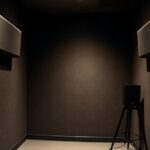Choosing between large and small speaker size settings affects your bass management and sound clarity. Setting speakers to large indicates they can handle full-range sounds, including deep bass, but this might cause muddiness if your room can’t support it well. Small settings direct bass to a subwoofer, ensuring cleaner sound. Proper placement and room treatment enhance both options. To get the most out of your system, understanding these details can make a real difference—discover more below.
Key Takeaways
- Setting speakers to large enables full-range sound but may cause muddiness if room acoustics aren’t ideal.
- Choosing small directs bass to subwoofers, improving clarity and preventing distortion from full-range speakers.
- Proper placement and room treatment are essential to optimize bass response regardless of speaker size setting.
- Large setting suits full-range drivers capable of deep bass, while small is better for speakers designed for mid/high frequencies.
- Balancing speaker size, placement, and room acoustics enhances overall sound quality and effective bass management.

Have you ever wondered how to optimize your speaker settings for the best sound quality? One of the most crucial factors is choosing the right speaker size setting—whether large or small—and properly managing bass frequencies. Your environment plays a significant role in this, especially when considering room acoustic treatment and speaker placement. These elements help guarantee that the sound you hear is balanced and clear, making the right size setting even more effective.
Optimizing speaker settings involves choosing the right size and managing bass for a clear, balanced sound.
When you set your speakers to large, you’re telling the system to treat them as full-range drivers capable of handling all frequencies, including deep bass. This setting is ideal if your speakers are designed to produce robust low-end sounds and if your room can support that bass without causing excessive reverberation or muddiness. However, if your speakers are not built for deep bass or if your room’s acoustic treatment isn’t designed to absorb or diffuse low-frequency waves, setting them to large can result in boomy, muddy sound. Proper speaker placement becomes critical here. Positioning your speakers away from walls or corners can help reduce excessive bass buildup, while strategic placement ensures the full-range sound is evenly distributed across your space.
Conversely, choosing small for your speakers signals that they’re better suited for mid and high frequencies, with the bass handled by a dedicated subwoofer. This is often the best choice for smaller speakers or systems where the main drivers aren’t designed for deep bass. When you go with small, you prevent the main speakers from attempting to reproduce frequencies they can’t handle effectively, which reduces distortion and muddiness. Bass management then directs low frequencies to the subwoofer, which is optimized for that purpose, resulting in a cleaner overall sound. Proper speaker placement is essential here too—placing your subwoofer in a spot where it can deliver even bass without causing rattles or boomy spots guarantees a balanced soundscape.
Ultimately, the decision between large and small isn’t just about your speakers; it’s about understanding how your room’s acoustic characteristics influence sound. Room acoustic treatment minimizes unwanted reflections and standing waves, making it easier to achieve a clear, balanced output regardless of your size setting. Additionally, understanding the contrast ratio of your projector can help you create an ideal viewing environment that complements your audio setup. Experimenting with placement and adjusting your speaker size setting based on your room’s acoustics can markedly elevate your listening experience. When you carefully match your speaker size setting with thoughtful placement and room treatment, you unlock the full potential of your audio system, enjoying richer, more accurate sound across all frequencies.
Frequently Asked Questions
How Does Speaker Size Affect Overall Audio Quality?
Your speaker size impacts overall audio quality by affecting speaker frequency response and audio clarity. Larger speakers handle lower frequencies better, producing richer bass, while smaller speakers excel at higher frequencies, offering clearer treble. Choosing the right size guarantees your sound system accurately reproduces audio, giving you balanced sound. When you match speaker size to your listening preferences, you experience improved clarity and a fuller, more immersive audio experience.
Should I Prioritize Speaker Size or Placement for Best Sound?
You should prioritize placement over speaker size for the best sound. Proper placement enhances room acoustics, ensuring balanced sound and clear dialogue, while speaker aesthetics help your setup look good without sacrificing performance. Even large speakers won’t perform well if placed poorly, so focus on positioning them correctly in your space. Good placement maximizes audio quality, complements room acoustics, and makes your speakers more effective regardless of their size.
Can Adjusting Speaker Size Settings Damage My Speakers?
Adjusting speaker size settings won’t damage your speakers if you use proper calibration techniques. These settings help optimize sound and maintain speaker durability by ensuring they’re not overdriven. Just make sure to set the correct size based on your speaker’s capabilities and avoid pushing them beyond their limits. Regular calibration and mindful volume levels safeguard your speakers and ensure consistent, high-quality audio performance without risking damage.
How Do I Know if My Subwoofer Is Set to Large or Small?
You can check if your subwoofer is set to large or small through your receiver’s settings menu or calibration process. During woofer calibration, listen for improved sound clarity and balanced bass. If your subwoofer sounds powerful and clear without distortion, it’s likely set correctly. Adjust the settings if you notice muffled sound or excessive bass, ensuring peak performance and protecting your equipment.
What Are Common Mistakes When Configuring Bass Management?
A common mistake is neglecting proper phase alignment, which can cause bass to sound thin or boomy. You also might not calibrate the crossover correctly, resulting in either too much or too little bass. Always double-check your crossover settings and verify your subwoofer’s phase aligns with your main speakers. Proper calibration guarantees smooth transitions and a balanced sound, avoiding muddiness or gaps in your bass response.
Conclusion
Choosing between large and small speaker size settings isn’t just a technical decision—it’s like tuning a fine instrument to create harmony in your home theater. By understanding how bass management works, you can craft a sound experience that’s as smooth as a symphony. So, take control of your setup and let your speakers sing their true song. After all, isn’t life better when your sound system hits all the right notes?















